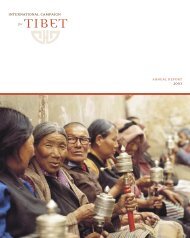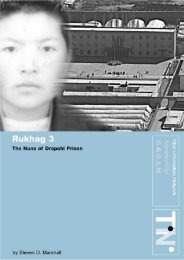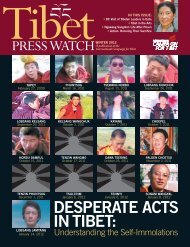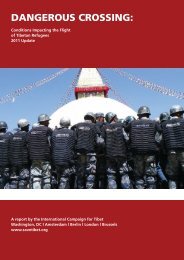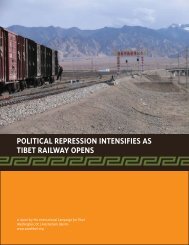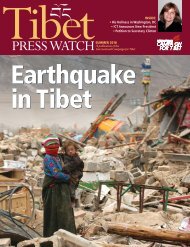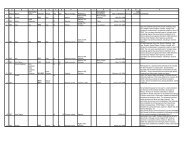download the report - International Campaign for Tibet
download the report - International Campaign for Tibet
download the report - International Campaign for Tibet
Create successful ePaper yourself
Turn your PDF publications into a flip-book with our unique Google optimized e-Paper software.
INTERNATIONAL CAMPAIGN FOR TIBET<br />
Former Director of <strong>the</strong> State Ethnic<br />
Affairs Commission, Li Dezhu<br />
Li Dezhu led <strong>the</strong> State Ethnic Affairs Commission (SEAC)<br />
from 1998 to 2007, and had served as Deputy Director since<br />
<strong>the</strong> early 1990s as well as being a Deputy Director of <strong>the</strong><br />
United Front Work Department (UFWD) (see below). Ethnically<br />
Korean, Li provided much of <strong>the</strong> background <strong>the</strong>ory<br />
and advice on <strong>the</strong> PRC’s minority peoples including<br />
<strong>Tibet</strong>ans and Uyghurs in order to guide implementation of<br />
<strong>the</strong> Western Development Strategy (WDS), a massive centrally<br />
planned economic strategy with political objectives<br />
critical to <strong>the</strong> leadership’s plan <strong>for</strong> China’s rise. 19<br />
Former Director of <strong>the</strong><br />
SEAC, Li Dezhu<br />
The purported aim of <strong>the</strong> WDS, initiated in 2000, is to<br />
accelerate economic development in <strong>the</strong> PRC’s impoverished<br />
western regions — where most of <strong>the</strong> country’s non-Chinese peoples live — to<br />
levels comparable with China’s wealthier eastern seaboard. However, so far at least,<br />
projects being carried out under <strong>the</strong> rubric of <strong>the</strong> WDS appear to be aimed at drawing<br />
on <strong>the</strong> western region’s natural resources <strong>for</strong> <strong>the</strong> benefit of distant markets in eastern<br />
China, as well as consolidating political control over <strong>the</strong> PRC’s vast western<br />
regions, which include all of <strong>Tibet</strong>. China’s continued economic growth is highly<br />
dependent upon fully utilizing <strong>the</strong> mineral deposits in China’s western regions, everything<br />
from <strong>the</strong> vast reserves of oil, gas, gold and copper through to <strong>the</strong> increasingly precious<br />
water resources found primarily on <strong>the</strong> <strong>Tibet</strong>an plateau.<br />
The WDS has also been one of <strong>the</strong> primary motivating factors <strong>for</strong> increased migration<br />
into <strong>Tibet</strong> and elsewhere in <strong>the</strong> western regions of <strong>the</strong> PRC by many of China’s hundreds<br />
of millions of migrant workers. Li Dezhu was one of <strong>the</strong> main champions of<br />
migration to <strong>Tibet</strong>, what he described in 2000 as a “two-way population flow”; and<br />
predicted a large flow of “talent” to head west in search of opportunities arising from<br />
<strong>the</strong> enormous investments <strong>the</strong>re. In 2001, China’s national legislature even amended<br />
<strong>the</strong> Regional Ethnic Autonomy Law (REAL) — a major piece of legislation which<br />
defines <strong>the</strong> legal terms and conditions of “autonomy” in <strong>Tibet</strong> — to encourage local<br />
authorities to offer “preferential treatment and encouragement” to “specialized personnel<br />
joining in <strong>the</strong> various kinds of construction” in <strong>Tibet</strong> and elsewhere. 20<br />
However, Li Dezhu also warned of <strong>the</strong> potential <strong>for</strong> “conflicts and clashes” between<br />
local ethnic peoples and Chinese migrants as a result of <strong>the</strong> WDS, according to an<br />
105



